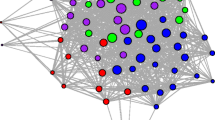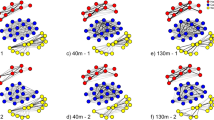Abstract
Group-living animals need to trade off the benefits and the costs of close proximity to conspecifics. Benefits can be increased, and costs reduced by preferentially choosing specific locations within a group best adjusted to an individual’s needs or by associating with specific group members and/or avoiding others. We investigated the spatial structure of meerkat (Suricata suricatta) groups and whether it was shaped by social factors such as affiliation or aggression among group members, predation risk, foraging success, or a mix of these different factors. Using social network analyses, based on spatial networks, we found associations between the dominant pair, among males and among same aged individuals, and dis-assortment by sex only in one to two of the six groups. In addition, the structure of meerkat groups was highly variable, as individual strength within the calculated networks was not repeatable over time. Meerkats seemed to adjust their location to their physical environment, as dominant individuals were located further toward the front of the group, where foraging success is likely higher and young individuals located further toward the back of the group, where they can benefit most from the vigilance effort of their conspecifics. We conclude that meerkat groups display a dynamic spatial structure depending on both the current social and physical environmental.
Significance
Group-living animals can achieve greater benefits from close association with conspecifics by choosing specific locations within a group or associating with specific group members and/or avoiding others. A considerable body of work has examined how differences in predation risk or foraging success affect the relative location of individuals within a group. Several studies investigated the association between individuals, in order to draw conclusions on the social structure. However, it is important to disentangle the impact of all of these different aspects on the spatial structure of a group. Here, we provide evidence that both the social and physical environment is important for the spatial assortment of meerkats, a social mongoose foraging in cohesive groups.

Similar content being viewed by others
References
Asensio N, Korstjens AH, Schaffner CM, Aureli F (2008) Intragroup aggression, fission-fusion dynamics and feeding competition in spider monkeys. Behaviour 145:983–1001
Barnard JA (2000) Foraging behaviour and social organisation in a cooperative mongoose, Suricata suricatta. PhD thesis, University of Cambridge, Cambridge
Bivand R, Lewin-Koh N (2016) maptools: tools for reading and handling spatial objects. R package version 0.8–39, https://CRAN.R-project.org/package=maptools
Bousquet CAH (2011) Group decision-making in Meerkats (Suricata suricatta). University of Zurich, PhD Thesis
Bumann D, Krause J, Rubenstein D (1997) Mortality risk of spatial positions in animal groups: the danger of being in the front. Behaviour 134:1063–1076
Butts CT (2014) sna: tools for social network analysis. R package version 2:3–2 https://CRAN.R-project.org/package=sna
Carter AJ, Macdonald SL, Thomson VA, Goldizen AW (2009) Structured association patterns and their energetic benefits in female eastern grey kangaroos, Macropus giganteus. Anim Behav 77:839–846
Carter AJ, Lee AEG, Marshall HH, Tico MT, Cowlishaw G (2015) Phenotypic assortment in wild primate networks: implications for the dissemination of information. R Soc open sci 2:13
Clutton-Brock T, Manser MB (2016) Meerkats: cooperative breeding in the Kalahari. Cambridge University Press, Cambridge
Clutton-Brock TH, Grynor D, Kansky R, MacColl ADC, Macllrath G, Chadwick P, Brotherton PNM, O'Riain JM, Manser MB, Skinner JD (1998) Costs of cooperative behavior in suricates (Suricata suricatta). Proc R Soc Lond B 265:185–190
Clutton-Brock TH, Gaynor D, McIlrath GM, MacColl ADC, Kansky R, Chadwick P, Manser M, Skinner JD, Brotherton PNM (1999a) Predation, group size and mortality in a cooperative mongoose, Suricata suricatta. J Anim Ecol 68:672–683
Clutton-Brock TH, O'Riain MJ, Brotherton PNM, Gaynor D, Kansky R, Griffin AS, Manser M (1999b) Selfish sentinels in cooperative mammals. Science 284:1640–1644
Croft DP, James R, Ward AJW, Botham MS, Mawdsley D, Krause J (2005) Assortative interactions and social networks in fish. Oecologia 143:211–219
Di Bitetti MS, Janson CH (2001) Social foraging and the finder's share in capuchin monkeys, Cebus apella. Anim Behav 62:47–56
Di Blanco Y, Hirsch BT (2006) Determinants of vigilance behavior in the ring-tailed coati (Nasua nasua): the importance of within-group spatial position. Behav Ecol Sociobiol 61:173–182
Doolan SP, Macdonald DW (1996) Diet and foraging behaviour of group-living meerkats, Suricata suricatta, in the southern Kalahari. J Zool 239:697–716
Farine DR (2016a) asnipe: animal social network inference and permutations for ecologists. R package version 0.91, https://CRAN.R-project.org/package=asnipe
Farine DR (2016b) assortnet: calculate the assortativity coefficient of weighted and binary networks. R package version 0.12, https://CRAN.R-project.org/package=assortnet
Farine DR, Whitehead H (2015) Constructing, conducting and interpreting animal social network analysis. J Anim Ecol 84:1144–1163
Farine DR (2014) Measuring phenotypic assortment in animal social networks: weighted associations are more robust than binary edges. Anim Behav 89:141–153
Gall GEC, Manser MB (2017) Group cohesion in foraging meerkats: follow the moving 'vocal hot spot'. R Soc open sci 4:6
Gama J (2014) NISTunits: fundamental physical constants and unit conversions from NIST. R package version 1.0.0, https://CRAN.R-project.org/package=NISTunits
Hall CL, Fedigan LM (1997) Spatial benefits afforded by high rank in white-faced capuchins. Anim Behav 53:1069–1082
Hamilton WD (1971) Geometry of the selfish herd. J Theor Biol 31:295–311
Hansen MJ, Schaerf TM, Krause J, Ward AJW (2016) Crimson spotted rainbowfish (Melanotaenia duboulayi) change their spatial position according to nutritional requirement. PLoS One 11:e0148334
Hijmans RJ (2015) geosphere: spherical trigonometry. R package version 1.5–1, https://CRAN.R-project.org/package=geosphere
Hirsch BT (2007) Costs and benefits of within-group spatial position: a feeding competition model. Q Rev Biol 82:9–27
Hirsch BT (2011) Within-group spatial position in ring-tailed coatis: balancing predation, feeding competition, and social competition. Behav Ecol Sociobiol 65:391–399
Hodge SJ, Flower TP, Clutton-Brock TH (2007) Offspring competition and helper associations in cooperative meerkats. Anim Behav 74:957–964
Hodge SJ, Thornton A, Flower TP, Clutton-Brock TH (2009) Food limitation increases aggression in juvenile meerkats. Behav Ecol 20:930–935
Huchard E, English S, Bell MBV, Thavarajah N, Clutton-Brock T (2016) Competitive growth in a cooperative mammal. Nature 533:532–534
Jordan NR, Cherry MI, Manser MB (2007) Latrine distribution and patterns of use by wild meerkats: implications for territory and mate defence. Anim Behav 73:613–622
Kranstauber B, Smolla M (2016) move: visualizing and analyzing animal track data. R package version 1.6.541, https://CRAN.R-project.org/package=move
Krause J, Ruxton GD (2002) Living in groups. Oxford University Press, Oxford
Krause J, Ruxton GD, Rubenstein D (1998) Is there always an influence of shoal size on predator hunting success? J Fish Biol 52:494–501
Kurvers R, Adamczyk V, Kraus RHS, Hoffman JI, van Wieren SE, van der Jeugd HP, Amos W, Prins HHT, Jonker RM (2013) Contrasting context dependence of familiarity and kinship in animal social networks. Anim Behav 86:993–1001
Kutsukake N, Clutton-Brock TH (2006) Agression and submission reflect reproductive conflict between females in cooperatively breeding meerkats Suricata suricatta. Behav Ecol Sociobiol 59:541–548
Madden JR, Kunc HP, English S, Manser MB, Clutton-Brock TH (2009) Calling in the gap: competition or cooperation in littermates' begging behaviour? Proc R Soc Lond B 276:1255–1262
Manser MB, Jansen D, Graw B, Hollen LI, Bousquet CAH, Furrer RD, le Roux A (2014) Vocal complexity in meerkats and other mongoose species. Adv Stud Behav 46:281–310
Patterson MR (1984) Patterns of whole colony prey capture in the octocoral, Alcyonium siderium. Biol Bull 167:613–629
R Core Team (2016) R: a language and environment for statistical computing. R Foundation for Statistical Computing, Vienna http://www.R-project.org
Rayor LS, Uetz GW (1990) Trade-offs in foraging success and predation risk with spatial position in colonial spiders. Behav Ecol Sociobiol 27:77–85
Rayor LS, Uetz GW (1993) Ontogenic shifts within the selfish herd - predation risk and foraging trade-offs change with age in colonial web-building spiders. Oecologia 95:1–8
Reber S, Townsend SW, Manser MB (2013) Social monitoring via close calls in meerkat. Proc R Soc B 280:20131013
Revelle W (2016) psych: procedures for personality and psychological research, version 1.6.4, http://CRAN.R-project.org/package=psych
Revelle W (2017) psych: procedures for personality and psychological research, version 1.7.8, https://CRAN.R-project.org/package=psych
Ruckstuhl K, Neuhaus P (2005) Sexual segregation in vertebrates: ecology of two sexes. Cambridge University Press, Cambridge
Shrout PE, Fleiss JL (1979) Interclass correlations—uses in assessing rater reliability. Psychol Bull 86:420–428
Spong GF, Hodge SJ, Young AJ, Clutton-Brock TH (2008) Factors affecting the reproductive success of dominant male meerkats. Mol Ecol 17:2287–2299
Sterck EHM, Watts DP, van Schaik CP (1997) The evolution of female social relationships in nonhuman primates. Behav Ecol Sociobiol 41:291–309
Teichroeb JA, White MMJ, Chapman CA (2015) Vervet (Chlorocebus pygerythrus) intragroup spatial positioning: dominants trade-off predation risk for increased food acquisition. Int J Primatol 36:154–176
Thavarajah NK, Fenkes M, Clutton-Brock TH (2014) The determinants of dominance relationships among subordinate females in the cooperatively breeding meerkat. Behaviour 151:89–102
Young AJ, Carlson AA, Monfort SL, Russell AF, Bennett NC, Clutton-Brock T (2006) Stress and the suppression of subordinate reproduction in cooperatively breeding meerkats. P Natl Acad Sci USA 103:12005–12010
Acknowledgments
We thank Tim Clutton-Brock and the Kalahari Research Trust for permission to work at the Kuruman River Reserve, and the neighbouring farmers to use their land. We also thank Tim Clutton-Brock, and Dave Gaynor for the organisation of the field site and their input on the field work, and the managers and volunteers of the Kalahari Meerkat Project (KMP) for maintaining the habituation and basic data collection on the meerkats. Furthermore, we thank Bruce Boatman, Denise Camenisch, and Pauline Toni for their assistance with focal recordings, Bart Kranstauber and Ariana Strandburg-Peshkin, for helpful discussions and suggestions for the analysis and Tim Clutton-Brock, Damien Farine, Matthew Silk, and two anonymous reviewers for very helpful comments. This paper has relied on records of individual identities and/or life histories maintained by the KMP, which has been supported by the European Research Council (Grant No 294494 to T.H. Clutton-Brock since 1/7/2012), the University of Zurich and the Mammal Research Institute at the University of Pretoria. We thank the Northern Cape Department of Environment and Nature Conservation for permission to conduct the research.
Funding
This study was funded by the Swiss National Science Foundation (Grant No PDFMP3_141768 to MBM).
Author information
Authors and Affiliations
Contributions
GECG and MBM collected the data with the help of three field assistants and GECG analysed the data. The article was written by both GECG and MBM. Both authors gave final approval for publication.
Corresponding author
Ethics declarations
Ethical approval
All data collection adhered to ASAB guidelines. All research was conducted under the permission of the ethical committee of Pretoria University (EC031-13) and the Northern Cape Conservation Service, South Africa (Permit number: FAUNA 192/2014).
Conflict of interest
The authors declare that they have no conflict of interest.
Additional information
Communicated by D. P. Croft
Electronic supplementary material
ESM 1
(DOCX 327 kb)
Rights and permissions
About this article
Cite this article
Gall, G.E.C., Manser, M.B. Spatial structure of foraging meerkat groups is affected by both social and ecological factors. Behav Ecol Sociobiol 72, 77 (2018). https://doi.org/10.1007/s00265-018-2490-x
Received:
Revised:
Accepted:
Published:
DOI: https://doi.org/10.1007/s00265-018-2490-x




